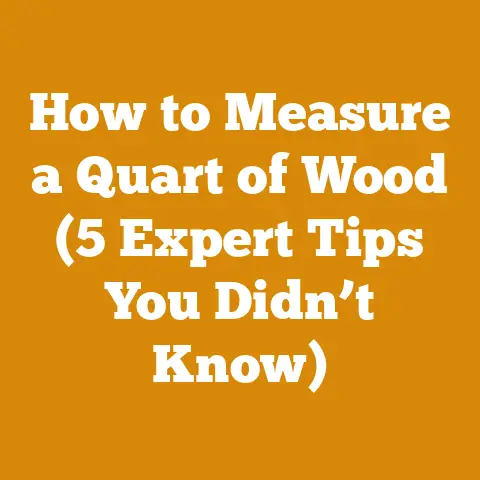How to Remove the Chainsaw Clutch (5 Pro Tips for Husqvarna)
Opening with a paradox: The very tool designed to cut through the toughest wood, the chainsaw, can sometimes be brought to a standstill by a seemingly small component – the clutch. It’s a critical part, and understanding how to remove it on your Husqvarna chainsaw is essential for maintenance and repairs. Yet, many shy away from this task, intimidated by the perceived complexity. I’m here to tell you it doesn’t have to be that way.
How to Remove the Chainsaw Clutch (5 Pro Tips for Husqvarna)
I’ve spent countless hours in the woods, felling trees, processing timber, and preparing firewood. Over the years, I’ve learned that proper maintenance is the key to keeping your chainsaw running smoothly. One of the most crucial, yet often overlooked, aspects of chainsaw maintenance is dealing with the clutch. The clutch is the unsung hero of your saw, responsible for transferring power from the engine to the chain. When it fails, your chainsaw is essentially useless.
This guide focuses specifically on Husqvarna chainsaws, known for their durability and performance. I’ll share my top 5 pro tips to help you confidently remove the clutch, whether you’re a seasoned logger or a weekend warrior preparing firewood. These tips are based on my personal experiences and insights, ensuring that you’re equipped with the knowledge and skills to tackle this task safely and effectively.
1. Understanding the Chainsaw Clutch: Anatomy and Function
Before diving into the removal process, it’s vital to understand what a chainsaw clutch is and how it works. The clutch is located behind the sprocket, which drives the chain. It’s typically a centrifugal clutch, meaning it engages when the engine reaches a certain RPM.
Here’s a breakdown of the key components:
- Clutch Drum: This is the outer part that the chain sprocket is attached to. It spins freely until the clutch engages.
- Clutch Springs: These springs control the engagement of the clutch shoes. They determine at what RPM the clutch will engage.
- Clutch Shoes (or Weights): These are the weighted arms that move outward when the engine revs up, engaging with the clutch drum.
- Clutch Hub: This is the central part that attaches to the crankshaft.
Function: When you start your chainsaw and increase the throttle, the engine’s crankshaft spins. As the RPMs increase, the clutch shoes are forced outward by centrifugal force. These shoes then grip the inside of the clutch drum, causing it to spin and, in turn, drive the chain. When the engine idles, the springs pull the shoes back, disengaging the clutch and stopping the chain.
Why understanding this matters: Knowing how each part works allows you to diagnose problems more effectively. For example, if your chain spins at idle, it could indicate worn clutch springs. Or, if your chain slips under load, it might be due to worn clutch shoes.
My experience: I once had a Husqvarna chainsaw that would only cut effectively at very high RPMs. After inspecting the clutch, I found that the clutch springs were stretched and weak. Replacing them restored the saw’s performance to its original cutting power.
2. Essential Tools and Safety Precautions
Safety is paramount when working with any power tool, especially chainsaws. Before you even think about touching your Husqvarna, gather the necessary tools and gear and ensure you’re following proper safety protocols.
Essential Tools:
- Clutch Removal Tool: This is a specialized tool designed to hold the piston in place while you loosen the clutch. There are different types, so make sure you get one that’s compatible with your Husqvarna model.
- Piston Stop (Alternative to Clutch Removal Tool): While a dedicated clutch removal tool is ideal, a piston stop can be used as an alternative. However, use it with caution as it can potentially damage the piston if not used correctly.
- Socket Wrench and Sockets: You’ll need a socket wrench and sockets to fit the clutch nut. Common sizes include 19mm and 21mm, but check your chainsaw’s manual for the specific size.
- Screwdriver: A flathead screwdriver may be needed to remove the spark plug and other components.
- Gloves: Protect your hands from sharp edges and debris.
- Eye Protection: Safety glasses or goggles are a must to prevent debris from entering your eyes.
- Penetrating Oil (Optional): If the clutch nut is stuck, penetrating oil can help loosen it.
- Torque Wrench: For re-installing the clutch nut to the correct torque specification.
Safety Precautions:
- Disconnect the Spark Plug: This is the most important safety step. Removing the spark plug ensures that the chainsaw cannot accidentally start while you’re working on it.
- Wear Safety Gear: Always wear gloves and eye protection.
- Work in a Well-Lit Area: Good lighting is essential for seeing what you’re doing and avoiding mistakes.
- Read the Manual: Familiarize yourself with your Husqvarna chainsaw’s manual before attempting any repairs.
- Be Aware of Your Surroundings: Make sure there are no distractions or hazards in your work area.
- Take Your Time: Rushing can lead to mistakes and injuries. Work methodically and carefully.
Important Note on Piston Stops: Using a piston stop can be risky. If inserted too far, it can damage the piston or cylinder. I recommend using a dedicated clutch removal tool whenever possible. If you must use a piston stop, ensure it’s the correct size and insert it gently.
My experience: I once forgot to disconnect the spark plug while working on a chainsaw. Fortunately, I didn’t accidentally start it, but it was a close call. This reinforced the importance of always following safety procedures.
3. Step-by-Step Guide to Removing the Clutch
Now that you have the tools and safety precautions in place, let’s get to the actual removal process. This guide assumes you are working on a typical Husqvarna chainsaw. However, specific steps may vary slightly depending on the model. Always refer to your chainsaw’s manual for detailed instructions.
Step 1: Preparation
- Place the chainsaw on a stable surface.
- Remove the chain and bar.
- Remove the spark plug.
- Engage the chain brake. This will help prevent the clutch drum from spinning.
Step 2: Accessing the Clutch
- Remove the clutch cover. This is typically held in place by a few screws or nuts.
- You should now see the clutch drum, which houses the sprocket.
- Remove the clutch drum by pulling it straight off the crankshaft.
Step 3: Securing the Piston
- This is where the clutch removal tool or piston stop comes in.
- Using a Clutch Removal Tool: Insert the tool into the spark plug hole and tighten it until it makes contact with the piston. This will prevent the piston from moving while you loosen the clutch nut.
- Using a Piston Stop: Carefully insert the piston stop into the spark plug hole until it gently touches the piston. Do not force it.
Step 4: Loosening the Clutch Nut
- Important: The clutch nut on most Husqvarna chainsaws has a left-hand thread. This means you need to turn it clockwise to loosen it.
- Attach the correct size socket to your socket wrench.
- Position the socket on the clutch nut.
- Apply firm, steady pressure and turn the wrench clockwise to loosen the nut.
- If the nut is stuck, apply penetrating oil and let it soak for a few minutes before trying again.
Step 5: Removing the Clutch
- Once the clutch nut is loose, remove it completely.
- Carefully remove the clutch assembly from the crankshaft. It may be slightly tight, but it should come off with gentle pressure.
Troubleshooting Tips:
- Clutch Nut Won’t Budge: If the clutch nut is extremely tight, try using an impact wrench. However, be careful not to damage the crankshaft.
- Clutch Assembly Stuck: If the clutch assembly is stuck, try gently tapping it with a rubber mallet. Avoid using excessive force, as this could damage the crankshaft.
My experience: I once struggled to remove a clutch nut that was seized on a Husqvarna chainsaw. After applying penetrating oil and letting it soak overnight, I was finally able to loosen it with an impact wrench.
4. Inspecting and Cleaning the Clutch Components
Once the clutch is removed, take the time to thoroughly inspect and clean all the components. This is an excellent opportunity to identify any potential problems and ensure that the clutch is functioning optimally.
Inspection:
- Clutch Shoes: Check the clutch shoes for wear and tear. Look for cracks, excessive wear, or glazing. If the shoes are worn down significantly, they need to be replaced. A good measurement is to check the lining thickness. If it’s below 1.5mm, replacement is recommended.
- Clutch Springs: Inspect the clutch springs for damage or stretching. If the springs are weak or broken, they will need to be replaced. Compare the length of the springs to a new set; if they are noticeably longer, they are likely stretched.
- Clutch Drum: Check the inside of the clutch drum for wear, scoring, or damage. A smooth, clean surface is essential for proper clutch engagement.
- Clutch Hub: Inspect the clutch hub for cracks or damage.
- Needle Bearing (Inside Clutch Drum): This is a critical but often overlooked component. It allows the clutch drum to spin freely. If it’s damaged, the clutch drum won’t spin freely, and the clutch will wear prematurely.
Cleaning:
- Use a Wire Brush: Use a wire brush to remove any rust, debris, or carbon buildup from the clutch shoes, clutch drum, and clutch hub.
- Use Brake Cleaner: Brake cleaner is an excellent solvent for removing grease and oil from the clutch components. Spray the parts liberally and wipe them clean with a rag.
- Compressed Air: Use compressed air to blow out any remaining debris from the clutch assembly.
Lubrication:
- Needle Bearing: Lightly lubricate the needle bearing inside the clutch drum with a high-quality grease. This will ensure smooth operation and prevent premature wear. Use a grease specifically designed for high-speed bearings.
Important Note on Replacement Parts: When replacing clutch components, always use genuine Husqvarna parts or high-quality aftermarket parts that are specifically designed for your chainsaw model. Using inferior parts can compromise the performance and reliability of your chainsaw.
My experience: I once neglected to inspect the needle bearing inside the clutch drum and ended up with a premature clutch failure. The damaged bearing caused excessive friction, which quickly wore down the clutch shoes.
5. Reinstalling the Clutch and Final Checks
Reinstalling the clutch is essentially the reverse of the removal process. However, there are a few key points to keep in mind to ensure a successful reassembly.
Step 1: Reinstalling the Clutch Assembly
- Carefully slide the clutch assembly onto the crankshaft.
- Make sure the clutch is seated properly and that the clutch hub is fully engaged with the crankshaft.
Step 2: Tightening the Clutch Nut
- Apply a drop of thread locker to the clutch nut threads. This will help prevent the nut from loosening over time.
- Position the clutch nut on the crankshaft.
- Using your socket wrench, tighten the clutch nut counter-clockwise (remember, it’s a left-hand thread).
- Use a torque wrench to tighten the nut to the manufacturer’s specified torque. This is crucial for ensuring proper clutch function and preventing damage to the crankshaft. The torque specification is typically around 35-45 Nm (26-33 ft-lbs), but always refer to your chainsaw’s manual.
Step 3: Removing the Clutch Removal Tool/Piston Stop
- Carefully remove the clutch removal tool or piston stop from the spark plug hole.
Step 4: Reinstalling the Spark Plug
- Reinstall the spark plug and tighten it to the manufacturer’s specified torque.
Step 5: Reinstalling the Clutch Drum and Chain
- Slide the clutch drum back onto the crankshaft.
- Reinstall the chain and bar.
- Adjust the chain tension according to the manufacturer’s instructions.
Step 6: Final Checks
- Start the chainsaw and let it idle.
- Check to see if the chain is spinning at idle. If it is, the clutch is not disengaging properly. This could be due to worn clutch springs or a misadjusted idle speed.
- Increase the throttle and check to see if the clutch engages smoothly and efficiently.
- Make a few test cuts to ensure that the chainsaw is cutting properly.
Common Mistakes to Avoid:
- Overtightening the Clutch Nut: Overtightening the clutch nut can damage the crankshaft or the clutch assembly. Always use a torque wrench to tighten the nut to the correct specification.
- Forgetting to Use Thread Locker: Forgetting to use thread locker can cause the clutch nut to loosen over time, leading to clutch failure.
- Improper Chain Tension: Improper chain tension can cause the chain to slip or bind, which can damage the chain, bar, and clutch.
- Using the Wrong Tools: Using the wrong tools can damage the clutch components or the chainsaw itself. Always use the correct tools for the job.
My experience: I once overtightened a clutch nut on a Husqvarna chainsaw and ended up stripping the threads on the crankshaft. This required a costly repair. This taught me the importance of using a torque wrench and following the manufacturer’s specifications.
Conclusion:
Removing and reinstalling the chainsaw clutch on your Husqvarna doesn’t have to be a daunting task. By following these 5 pro tips, you can confidently tackle this maintenance procedure and keep your chainsaw running smoothly for years to come. Remember to prioritize safety, use the correct tools, and take your time. With a little practice, you’ll be able to remove and reinstall the clutch like a pro.
By understanding the anatomy and function of the clutch, following safety precautions, using the right tools, inspecting and cleaning the components, and carefully reinstalling the clutch, you can ensure that your Husqvarna chainsaw performs at its best. Don’t be afraid to get your hands dirty and learn about the inner workings of your chainsaw. It’s an investment that will pay off in the long run.
Now, armed with this knowledge, go forth and conquer those logs! And remember, a well-maintained chainsaw is a happy chainsaw (and a happy logger!).






